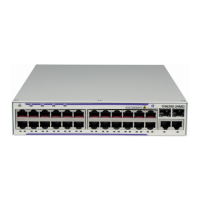Virtual Private LAN Services
7210 SAS M Services Guide Page 323
SAP Path Cost
The SAP path cost is used by STP to calculate the path cost to the root bridge. The path cost in
BPDUs received on the root port is incremented with the configured path cost for that SAP. When
BPDUs are sent out other egress SAPs, the newly calculated root path cost is used.
STP suggests that the path cost is defined as a function of the link bandwidth. Since SAPs are
controlled by complex queuing dynamics, in the 7210 SAS M the STP path cost is a purely static
configuration.
The default value for SAP path cost is 10. This parameter can be modified within a range of 1 to
65535, 1 being the lowest cost.
CLI Syntax: config>service>vpls>sap>stp#
path-cost sap-path-cost
Range:
1 to 200000000
Default: 10
Restore Default: no path-cost
SAP Edge Port
The SAP
edge-port command is used to reduce the time it takes a SAP to reach the forwarding
state when the SAP is on the edge of the network, and thus has no further STP bridge to handshake
with.
The
edge-port command is used to initialize the internal OPER_EDGE variable. At any time,
when OPER_EDGE is false on a SAP, the normal mechanisms are used to transition to the
forwarding state (see Forward Delay on page 315). When OPER_EDGE is true, STP assumes that
the remote end agrees to transition to the forwarding state without actually receiving a BPDU with
an agreement flag set.
The OPER_EDGE variable will dynamically be set to false if the SAP receives BPDUs (the
configured edge-port value does not change). The OPER_EDGE variable will dynamically be set
to true if auto-edge is enabled and STP concludes there is no bridge behind the SAP.
When STP on the SAP is administratively disabled and re-enabled, the OPER_EDGE is re-
initialized to the value configured for edge-port.
Valid values for SAP edge-port are enabled and disabled with disabled being the default.
CLI Syntax: config>service>vpls>sap>stp#
[no] edge-port
Default: no edge-port

